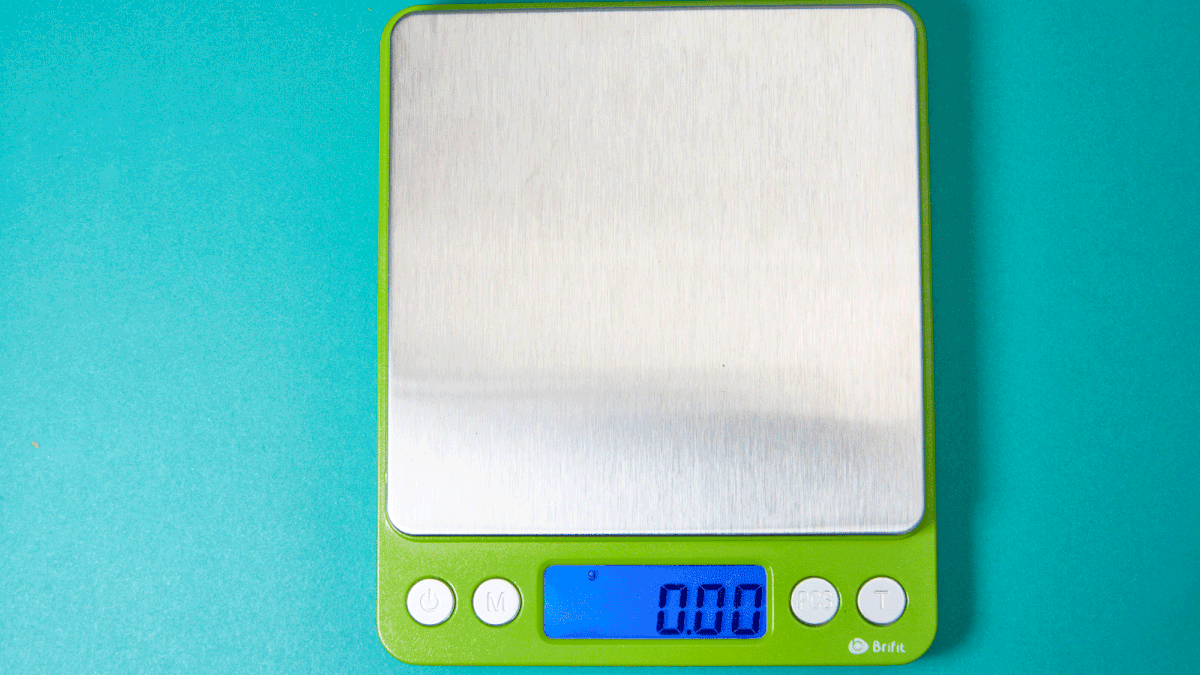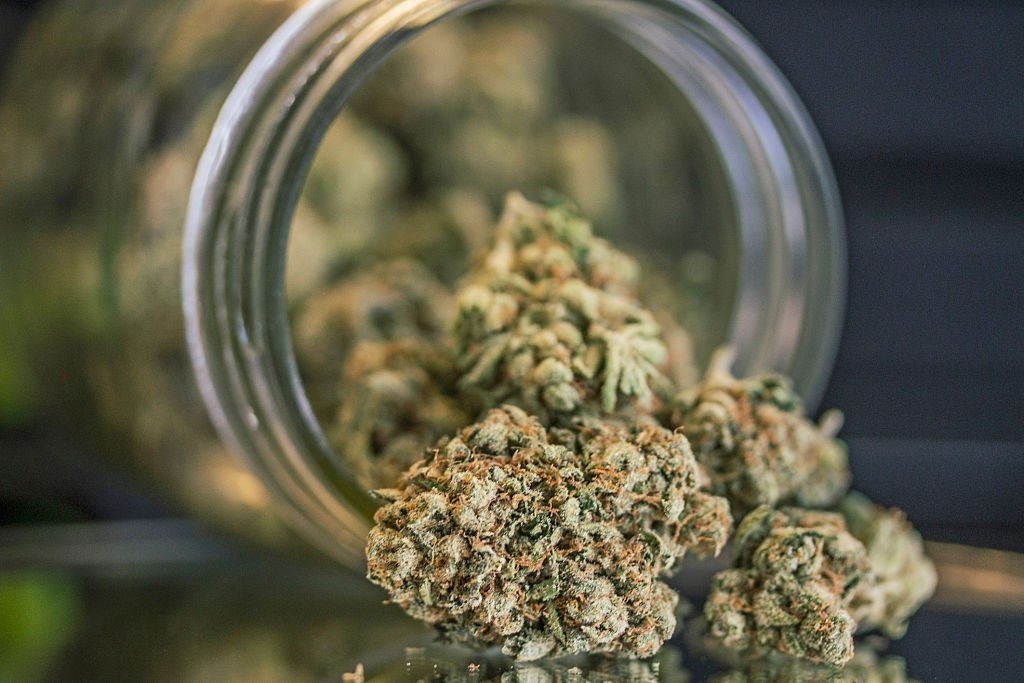“Marijuana” and “math” aren’t words you often hear in the same sentence. However, if you’re a fan of smoking MJ, reviewing basic weed measurements could help you stack buds responsibly. All tokers should strive to master the science of converting imperial ounces into metric grams.
From Dime Bags To Zips — The Most Common Weed Measurements

We get it; measuring weed weights is nowhere near as fun as smoking sticky nugs. However, knowing your “ganja grams” could save you a whole lot of moolah. If you’re only buying a dime of weed at a time, you may be missing out on deep discounts. Alternatively, ordering too much cannabis could put you in trouble with the law. For these reasons, it’s crucial to review the basics of weed measurements.
How To Many Grams Is A Dime of Weed — 1 Gram “Dime Bags”
With so many new hybrids entering the marijuana market, it can be tricky to tell what’ll jive with your tastebuds. In these cases, you may want to order the “kiddie size” equivalent of a strain. This begs the question, just how low do cannabis sizes go?
Traditionally, the smallest recognized marijuana measurement is a gram of weed. In imperial terms, this equates to about 1/28 of an ounce. Since these nugs are so small, you should only expect to get about 1 – 2 joint sessions out of them.
In the days before pot prohibition, 1 gram of weed was commonly referred to as a “dime bag.” Unsurprisingly, these bags typically cost $10 a pop—but they’re usually more expensive in today’s dispensary market. Depending on taxes and the quality of your strain, you may have to pay $20 – $25 for a dime of weed.
While these weed prices may seem cheap compared with larger sizes, you’re usually paying a premium when you order one-gram bags. As with any other product, it’s always cheaper to buy in bulk. The more weed you buy, the more likely you’re saving per gram.
That being said, buying a dime bag is a good option if you want to try a new cannabis strain without paying a ton upfront. If you don’t like how your new hybrid tastes, at least you won’t have to worry about tossing out a massive pile of nugs.
A Double Scoop — Two Gram “Dub Sacks”
The next step up from a dime bag is 2 grams of weed (aka a “dub sack”). Since this is double the weed in a one-gram bag, it’s no surprise dub sacks will last you twice as long. On average, dub sacks can fill between 2 – 4 joints.
Traditionally, vendors sold dub sacks for double the price of dime bags. However, if you see a $20 dub sack in today’s market, you should be skeptical about its quality. Most often, high-grade two-gram bags retail in the $30 range.
Reliable “Weekly Weed” — ⅛ Ounce Bags
Once you move above 3 grams in the marijuana world, everything suddenly shifts to imperial measurements. We’ll admit, this system isn’t super accurate because you have to round off the number of grams. However, until every dispensary agrees to convert everything to grams, weed lovers have to roll with these measurements.
The lowest unit typically listed in ounces is a ⅛ ounce bag, which correlates with ~ 3.5 grams. This weed measurement is one of the most popular choices because it’s easy to store, relatively affordable, and lasts for about one week. On average, you could get 6 – 8 joint sessions with a ⅛ ounce bag of weed.
Pricewise, you could usually find ⅛ ounce marijuana between $30 – $50. If you see an eighth of weed in the $20 range, you should be skeptical about its quality.
Oh yeah, just so you know, some people refer to ⅛ ounce as a “slice.” However, since an 8th is such a standard size in dispensaries, you probably won’t need to resort to using canna-slang.
Kickin’ It With A Quarter of Weed — ¼ Ounce Bags
While ⅛ oz is one of the most popular weed measurements, some customers may prefer extending their weed session for one more week, so they go for a quarter of weed. If that’s true, you should consider bumping up to “a quad.”
In case you couldn’t tell, “quad” is slang for a ¼ oz bag of weed (or 7 grams in metric terms). Just like moving from a dime bag to a dub sack, going from a slice to a quad means you’ll enjoy double the product for double the price. Generally, people can roll about 12 – 15 joints with a ¼ oz bag, and prices range from $35 – $70.
A Month’s Worth Of MJ — ½ Ounce Bag
If you only like to visit your dispensary once per month, ½ oz bags are probably the way to go. Sometimes called a “half-O,” this weed measurement contains about 14 grams of cannabis. If you were to have one average-sized joint per day, this amount would likely supply you with enough pot for four weeks.
The price of a half-O typically doesn’t go below $90—at least for decent quality weed. If you’re stacking up on a premier strain, then you should expect to pay $100 – $200 for your flowers.
Time For The Big O — One Ounce Bags
Since ½ oz bags are known as “half-Os,” you’ve probably already guessed what “O” means. That’s right, an “O” in cannabis circles refers to one ounce of weed (or about 28 grams).
In most dispensaries, you won’t find cannabis flowers offered in any size larger than one ounce. That’s due to the possession limits in Canada and US states with recreationally legal pot. Unless otherwise stated by your legislature, you can only have one ounce of marijuana at your home at any given time.
While this may seem like an unfair restriction, there are a few good reasons for this cutoff. Most significantly, states must ensure you’re not illegally selling cannabis without registering with the proper authorities. Plus, one ounce of weed is plenty!
For a bit of perspective, most people claim one ounce of weed is equivalent in size to a coconut. In joint terms, you could safely enjoy ~ 100 smoke sessions with an ounce of weed.
Just be prepared to pay upwards of $200 – $300 for an ounce of high-quality bud. While you could sometimes find one-ounce bags for around $150, the good stuff is almost always above $200. Still, in gram terms, a $200 ounce of weed is cheaper than buying a bunch of dime bags.
FYI: One-ounce weed is frequently called a “zip” due to its association with Ziploc bags. However, it’s best not to keep your ounce of buds in plastic bags if you want to preserve their potency. If you’re going to store this amount of weed, you should invest in airtight containers and keep your weed far from heat, humidity, and light.
Can You Order More Than One Ounce Of Weed?
As we just mentioned, buying more than one ounce of recreational weed is illegal in Canadian provinces and US states with lenient cannabis laws. While these laws may change in the future, it’s best not to push these possession limits. Even going a few grams over the one-ounce cutoff could land you in serious legal trouble.
However, that doesn’t mean there aren’t a few ways you could legally order over one ounce of marijuana. For instance, if you’re a registered medical marijuana patient, it may be possible to order more cannabis from your favorite dispensary. In these cases, however, you will need a note from your doctor specifying your marijuana requirements. To better understand your state’s medical marijuana limits, it’s best to speak with your local Department of Health.
Of course, if you’re a legal cannabis retailer, extractor, or manufacturer, then you should have no issues ordering wholesale weed from farms. Just ensure that you have all the proper licenses from organizations like the Department of Agriculture before submitting a bulk order for weed.
As a final note, some states don’t count homegrown weed as the total amount you could have at one time. So, if you buy an ounce from a dispensary, you may still be able to cultivate a few cannabis plants at home. For more specific info on how homegrown weed factors into possession limits, please review your state’s recreational cannabis laws.
How Do Dispensaries Measure Cannabis Concentrates?
Ironically, cannabis concentrates pack a bigger punch in smaller units! Unlike cannabis flowers, you probably won’t see concentrates listed in ounces at dispensaries. But don’t let their tinier weight fool you. Usually, it takes ¼ oz of cannabis flower to make one gram of concentrate.
Generally, concentrates are measured in grams and milligrams. In fact, most popular concentrates like shatter, budder, or wax are sold in 0.5 g – 1 g containers. However, you can often find solid hashish sold in multi-gram quantities. According to most tokers, one gram of concentrate should last you as long as ¼ oz of weed, but that all depends on how often and how heavily you use it.
Please remember your concentrate’s total weight doesn’t correlate with its cannabinoid count. For that, you’ll have to look at the percentage of THC or CBD on your product’s lab results. You may also see the total cannabinoid count listed in milligrams on your concentrate’s packaging.
Prices vary wildly depending on what concentrate you’re ordering. For instance, cold-extracted live resin is always pricier than extracts that use solvents like butane. However, you should expect to pay within the $50 – $80 per gram for a high-quality cannabis extract.
Please remember that concentrates are a separate category in cannabis law. This means you can’t apply the same possession limits associated with cannabis flowers on concentrates. For instance, California law only allows residents to possess eight grams of concentrate at any given time. Washington State says residents could only have seven grams of cannabis concentrates.
As always, please check the laws in your area for specific guidance on cannabis possession limits.
What Are Typical Weed Measurements For Edibles?
Weed measurements on edible products are similar to concentrates, but they’re well below the levels you’ll find on dabbable goods. Most industry experts claim the average THC dose per edible is around 10 – 15 mg.
While these estimates are worth keeping in mind, the total cannabinoids in edibles can vary significantly from product to product. Indeed, cannabis edibles could have as low as 1 mg active cannabinoids or upwards of 100 mg per serving.
Since there’s such a wide range of edible products and concentrations, it isn’t easy to give an average price prediction. However, recent evidence suggests the average price in today’s edibles market is around $0.25 per milligram of THC or CBD. This price may fluctuate as the cannabis market matures, but it’s worth keeping in mind as you assess different products.
Should You Measure Weed Before Buying?
Even if you buy your buds in bulk, weed is an expensive habit. Since you’re spending quite a bit for these buds, it’s always important to double-check you’re getting your money’s worth.
Please ask your budtender to weigh your weed on a scale before checking out. All dispensaries should have a reliable measuring device in-house to price their buds accurately. If your dispensary refuses to weigh your weed before you make a purchase, then there’s probably something fishy going on.
How To Measure Weed Without A Scale?
Ideally, you should get your weed measured at a dispensary so you know how much you have. However, will be times when you can’t ask an employee for a measurement. For instance, you may get weed delivered from a store or an MMJ caretaker. Alternatively, you may be cultivating cannabis at home and want to figure out your average weed amounts. In these common scenarios, how do you measure weed without a scale?
Arguably, the simplest way to measure weed without a scale is to use a “ruler seesaw.” Put a pen or pencil under the middle of a ruler and wait for it to balance out. Next, grab a few pennies and your weed. Place one penny on one end of the ruler and one bud on the other side. Keep repeating this step until you see how many pennies it takes to balance with your buds.
This trick works so well because an average penny weighs 2.5 g. So, when you find the number of pennies it takes to equal out your weed, you know roughly how many grams you have in your possession.
Can You Measure Weed’s Potency At Home?
While measuring a flower’s cannabinoid percentage at home isn’t super simple, it’s getting easier to find scanning kits on the cannabis market. While these scanning units may be a bit of an investment, they could help marijuana consumers better understand each strain’s potency levels, which is crucial for daily dosing and making DIY edibles.
Unfortunately, there are no “at-home hacks” you could use to measure your flower’s cannabinoid content. You will need to research at-home potency scanners designed for cannabis if you want high-quality results in a matter of minutes.
Tip The Scales In Your Favor With Accurate Weed Measurements
One of the unexpected side effects of becoming a toker is learning a bit about weight conversions. While it will take time to memorize average cannabis measurements, knowing these weights will help you immensely on your MJ shopping trip.
As a final tip: Please remember there are roughly 28 grams in one ounce. So, you could always get a ballpark figure dividing or multiplying by 28.

